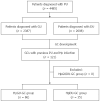Characteristics of gastric cancer in peptic ulcer patients with Helicobacter pylori infection
- PMID: 25945009
- PMCID: PMC4408468
- DOI: 10.3748/wjg.v21.i16.4954
Characteristics of gastric cancer in peptic ulcer patients with Helicobacter pylori infection
Abstract
Aim: To evaluate the incidence and clinical characteristics of gastric cancer (GC) in peptic ulcer patients with Helicobacter pylori (H. pylori) infection.
Methods: Between January 2003 and December 2013, the medical records of patients diagnosed with GC were retrospectively reviewed. Those with previous gastric ulcer (GU) and H. pylori infection were assigned to the HpGU-GC group (n = 86) and those with previous duodenal ulcer (DU) disease and H. pylori infection were assigned to the HpDU-GC group (n = 35). The incidence rates of GC in the HpGU-GC and HpDU-GC groups were analyzed. Data on demographics (age, gender, peptic ulcer complications and cancer treatment), GC clinical characteristics [location, pathological diagnosis, differentiation, T stage, Lauren's classification, atrophy of surrounding mucosa and intestinal metaplasia (IM)], outcome of eradication therapy for H. pylori infection, esophagogastroduodenoscopy number and the duration until GC onset were reviewed. Univariate and multivariate analyses were performed to identify factors influencing GC development. The relative risk of GC was evaluated using a Cox proportional hazards model.
Results: The incidence rates of GC were 3.60% (86/2387) in the HpGU-GC group and 1.66% (35/2098) in the HpDU-GC group. The annual incidence was 0.41% in the HpGU-GC group and 0.11% in the HpDU-GC group. The rates of moderate-to-severe atrophy of the surrounding mucosa and IM were higher in the HpGU-GC group than in the HpDU-GC group (86% vs 34.3%, respectively, and 61.6% vs 14.3%, respectively, P < 0.05). In the univariate analysis, atrophy of surrounding mucosa, IM and eradication therapy for H. pylori infection were significantly associated with the development of GC (P < 0.05). There was no significant difference in the prognosis of GC patients between the HpGU-GC and HpDU-GC groups (P = 0.347). The relative risk of GC development in the HpGU-GC group compared to that of the HpDU-GC group, after correction for age and gender, was 1.71 (95%CI: 1.09-2.70; P = 0.02).
Conclusion: GU patients with H. pylori infection had higher GC incidence rates and relative risks. Atrophy of surrounding mucosa, IM and eradication therapy were associated with GC.
Keywords: Duodenal ulcer; Eradication therapy; Gastric cancer; Gastric ulcer; Helicobacter pylori.
Figures

References
-
- McColl KE. Clinical practice. Helicobacter pylori infection. N Engl J Med. 2010;362:1597–1604. - PubMed
-
- Parsonnet J, Friedman GD, Vandersteen DP, Chang Y, Vogelman JH, Orentreich N, Sibley RK. Helicobacter pylori infection and the risk of gastric carcinoma. N Engl J Med. 1991;325:1127–1131. - PubMed
-
- Stewart BW, Kleihues P. World cancer report. Lyon: IARC Press; 2003. p. 194.
-
- Parsonnet J, Harris RA, Hack HM, Owens DK. Modelling cost-effectiveness of Helicobacter pylori screening to prevent gastric cancer: a mandate for clinical trials. Lancet. 1996;348:150–154. - PubMed
-
- Hopkins RJ, Girardi LS, Turney EA. Relationship between Helicobacter pylori eradication and reduced duodenal and gastric ulcer recurrence: a review. Gastroenterology. 1996;110:1244–1252. - PubMed
Publication types
MeSH terms
Substances
LinkOut - more resources
Full Text Sources
Other Literature Sources
Medical
Miscellaneous

